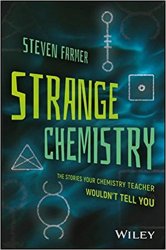Strange Chemistry: The Stories Your Chemistry Teacher Wouldn't Tell You
- Добавил: harun54
- Дата: 23-02-2019, 15:39
- Комментариев: 0
 Название: Strange Chemistry: The Stories Your Chemistry Teacher Wouldn't Tell You
Название: Strange Chemistry: The Stories Your Chemistry Teacher Wouldn't Tell YouАвтор: Steven Farmer
Издательство: Wiley
Год: 2017
Формат: PDF
Размер: 20 Мб
Язык: английский / English
This book opens the audience’s eyes to the extraordinary scientific secrets hiding in everyday objects. Helping readers increase chemistry knowledge in a fun and entertaining way, the book is perfect as a supplementary textbook or gift to curious professionals and novices.
• Appeals to a modern audience of science lovers by discussing multiple examples of chemistry in everyday life
• Addresses compounds that affect everyone in one way or another: poisons, pharmaceuticals, foods, and illicit drugs; thereby evoking a powerful emotional response which increases interest in the topic at hand
• Focuses on edgy types of stories that chemists generally tend to avoid so as not to paint chemistry in a bad light; however, these are the stories that people find interesting
• Provides detailed and sophisticated stories that increase the reader’s fundamental scientific knowledge
• Discusses complex topics in an engaging and accessible manner, providing the “how” and “why” that takes readers deeper into the stories
What is the most important chemical reaction? Steven Farmer says it's the Haber process N2 + 3H2 ? 2NH3, which is used to make fertilizer. Without it, half the ice-free land mass on Earth would be needed to grow food instead of 15%, and 40% of the people on Earth would starve. It's estimated that 80% of the nitrogen in your body was produced artificially through the Haber process. That's one of the bedtime stories you could tell your children after reading this fascinating book. Farmer is a chemistry professor at Sonoma State University, and discovered that telling his students useful information like this once in a while kept them interested.Other stories are about how common products can cause death if ingested.
Artist Andy Warhol died from water intoxication after being overloaded with fluids in the hospital. People have gone to prison for giving Visine or Ben-Gay, which are poisonous, to their friends as a "prank." In fact, drinking pure wintergreen oil (aka methyl salicylate), one of the ingredients in Ben-Gay, was once a common way of committing suicide. It didn't take much. Why does touching a coin produce a metallic smell? Why would lightning appear orange on Jupiter? Where does the caffeine in Diet Coke come from? Why is Teflon slippery? Why is it impossible to toast gluten-free bread? It's in the book. It's written in layman's terms, and almost anyone would get something out ofit. In our chemical- and drug-filled world knowing this stuff can save your life. More importantly, it could get people interested in chemistry . . . and maybe even biochemistry . . . and inorganic . . . .Watch for this stuff to show up on TV some day. Review from Randombio.com
A chemistry professor teaches "the stories your chemistry teachers wouldn't tell you" through short, accessible lessons on drugs, deadly household items,mysteries of ordinary objects, and more. Debut author Farmer (Chemistry/Sonoma State Univ.) devoted his life to chemistry after a high school friend on LSD jumped in front of a car and was killed instantly. He was driven by a quest to better understand hallucinogens and their effect on the brain, but he also wanted answers to other questions that haunted his childhood. When Farmer became a chemistry instructor,he noticed that he would regularly stump his classroom when he asked aquestion that provides the title of a subsection here: "What Substance is Used to Make 80% of All Pharmaceuticals?" His shock regarding how little the general public knows about chemistry led to him to write this book. In it, he does go into drug-related topics, such as how methamphetamines act as a stimulant, but also addresses much more than just chemical extremes. The lessons include images of molecular structures; others include funny cartoons, such as an elephant balancing on a pencil to represent graphene's strength. The short sections and accessible language will keep readers' attention, and the frequent addition of molecular structures could be a useful addition to chemistry courses.
Внимание
Уважаемый посетитель, Вы зашли на сайт как незарегистрированный пользователь.
Мы рекомендуем Вам зарегистрироваться либо войти на сайт под своим именем.
Уважаемый посетитель, Вы зашли на сайт как незарегистрированный пользователь.
Мы рекомендуем Вам зарегистрироваться либо войти на сайт под своим именем.
Информация
Посетители, находящиеся в группе Гости, не могут оставлять комментарии к данной публикации.
Посетители, находящиеся в группе Гости, не могут оставлять комментарии к данной публикации.
